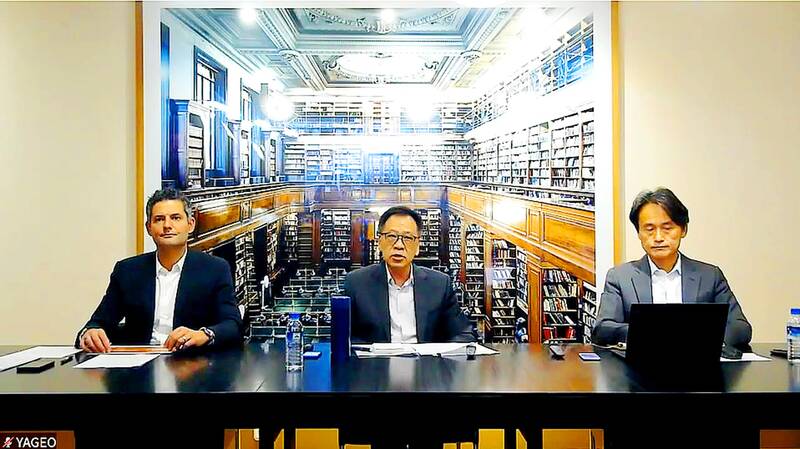Yageo Corp (國巨), the world’s third-largest supplier of multilayer ceramic capacitors (MLCCs), yesterday projected that its revenue would be little changed this quarter and the next on a sequential basis, as signs of an exuberant recovery are lacking.
With a lukewarm increase in end-market demand, the passive components maker expects channel inventory adjustments to continue for another one to two quarters.
Yageo’s conservative outlook came as the firm reported its weakest profit in nine quarters last quarter.

Photo: Chang Hui-wen, Taipei Times
Net profit for the April-to-June quarter tumbled 37 percent to NT$3.73 billion (US$119.15 million), from NT$5.93 billion in the same period last year. That represented a decline of 9.7 percent from NT$4.13 billion a quarter earlier.
“The current market [condition] seems to have reached the bottom. However, we haven’t seen signs of very strong demand yet,” Yageo CEO David Wang (王淡如) told an online investors’ conference.
Revenue would be flat this quarter compared with NT$26.76 billion a quarter earlier, Wang said, adding that gross margin would be flat, or improve slightly from 33.2 percent last quarter.
Overall, Yageo expects to generate more revenue in the second half of the year than the first half, Wang said.
To cope with tepid market demand while reducing its inventory further, Yageo would extend its one-year factory utilization control policy into this quarter, the company said.
The day-of inventory gauge stood at 129 days last quarter, higher than the firm’s target of fewer than 120 days, it said.
The utilization of manufacturing equipment for premier passive components would remain at about 70 percent this quarter — the same as last quarter, Yageo said, adding that the usage of manufacturing equipment for commodity-type products would be 40 to 50 percent.
Yageo said it has recently seen signs of a recovery in its MLCC business, as customers have started restocking inventory lately.
The company’s MLCC business was its second-largest revenue contributor last quarter, accounting for 22 percent of its total sales.
Demand from the car, electric vehicle and industrial segments would remain robust in the second half of the year, extending the growth recorded in the first half, Yageo executive vice president of global sales and marketing Claudio Lollini said.
However, the demand profile for desktop computers, notebook computers and smartphones remains lackluster, Lollini said.
Yageo did not see any major decline in its average selling prices, aside from seasonal adjustments, he added.
Lollini said it would be difficult to quantify how many business opportunities the adoption of artificial intelligence chips would bring to the company, but it is certain that each AI server is equipped with many more components than a traditional server.
Yageo’s MLCCs and chip resistors have exposure to the AI market, he added.

TAKING STOCK: A Taiwanese cookware firm in Vietnam urged customers to assess inventory or place orders early so shipments can reach the US while tariffs are paused Taiwanese businesses in Vietnam are exploring alternatives after the White House imposed a 46 percent import duty on Vietnamese goods, following US President Donald Trump’s announcement of “reciprocal” tariffs on the US’ trading partners. Lo Shih-liang (羅世良), chairman of Brico Industry Co (裕茂工業), a Taiwanese company that manufactures cast iron cookware and stove components in Vietnam, said that more than 40 percent of his business was tied to the US market, describing the constant US policy shifts as an emotional roller coaster. “I work during the day and stay up all night watching the news. I’ve been following US news until 3am

UNCERTAINTY: Innolux activated a stringent supply chain management mechanism, as it did during the COVID-19 pandemic, to ensure optimal inventory levels for customers Flat-panel display makers AUO Corp (友達) and Innolux Corp (群創) yesterday said that about 12 to 20 percent of their display business is at risk of potential US tariffs and that they would relocate production or shipment destinations to mitigate the levies’ effects. US tariffs would have a direct impact of US$200 million on AUO’s revenue, company chairman Paul Peng (彭雙浪) told reporters on the sidelines of the Touch Taiwan trade show in Taipei yesterday. That would make up about 12 percent of the company’s overall revenue. To cope with the tariff uncertainty, AUO plans to allocate its production to manufacturing facilities in

Six years ago, LVMH’s billionaire CEO Bernard Arnault and US President Donald Trump cut the blue ribbon on a factory in rural Texas that would make designer handbags for Louis Vuitton, one of the world’s best-known luxury brands. However, since the high-profile opening, the factory has faced a host of problems limiting production, 11 former Louis Vuitton employees said. The site has consistently ranked among the worst-performing for Louis Vuitton globally, “significantly” underperforming other facilities, said three former Louis Vuitton workers and a senior industry source, who cited internal rankings shared with staff. The plant’s problems — which have not

COLLABORATION: Given Taiwan’s key position in global supply chains, the US firm is discussing strategies with local partners and clients to deal with global uncertainties Advanced Micro Devices Inc (AMD) yesterday said it is meeting with local ecosystem partners, including Taiwan Semiconductor Manufacturing Co (TSMC, 台積電), to discuss strategies, including long-term manufacturing, to navigate uncertainties such as US tariffs, as Taiwan occupies an important position in global supply chains. AMD chief executive officer Lisa Su (蘇姿丰) told reporters that Taiwan is an important part of the chip designer’s ecosystem and she is discussing with partners and customers in Taiwan to forge strong collaborations on different areas during this critical period. AMD has just become the first artificial-intelligence (AI) server chip customer of TSMC to utilize its advanced